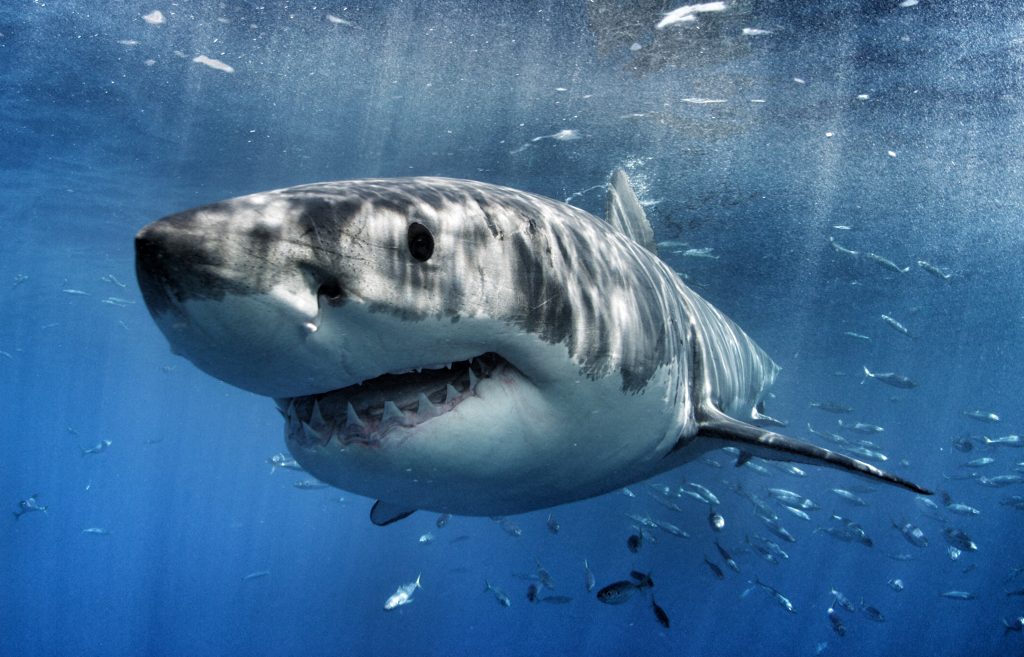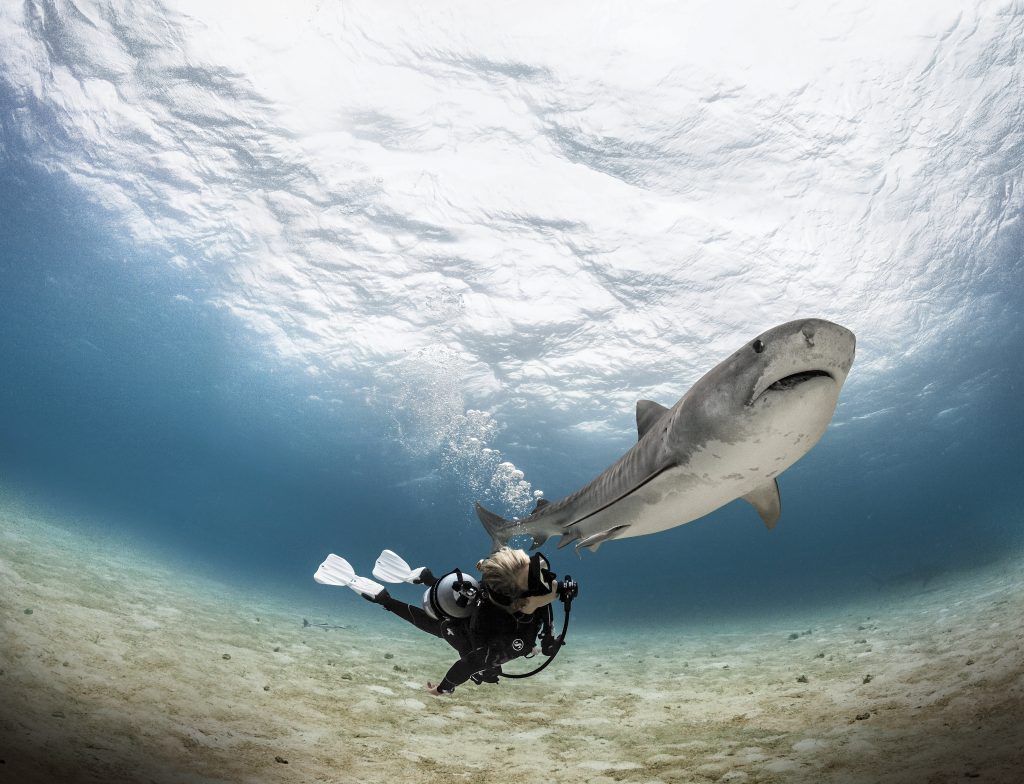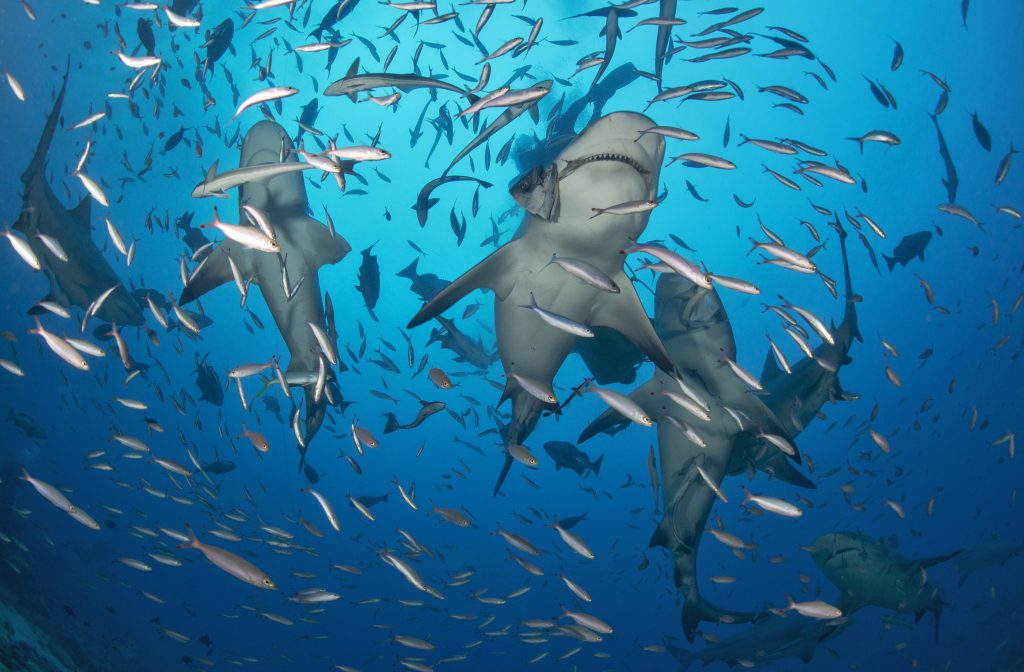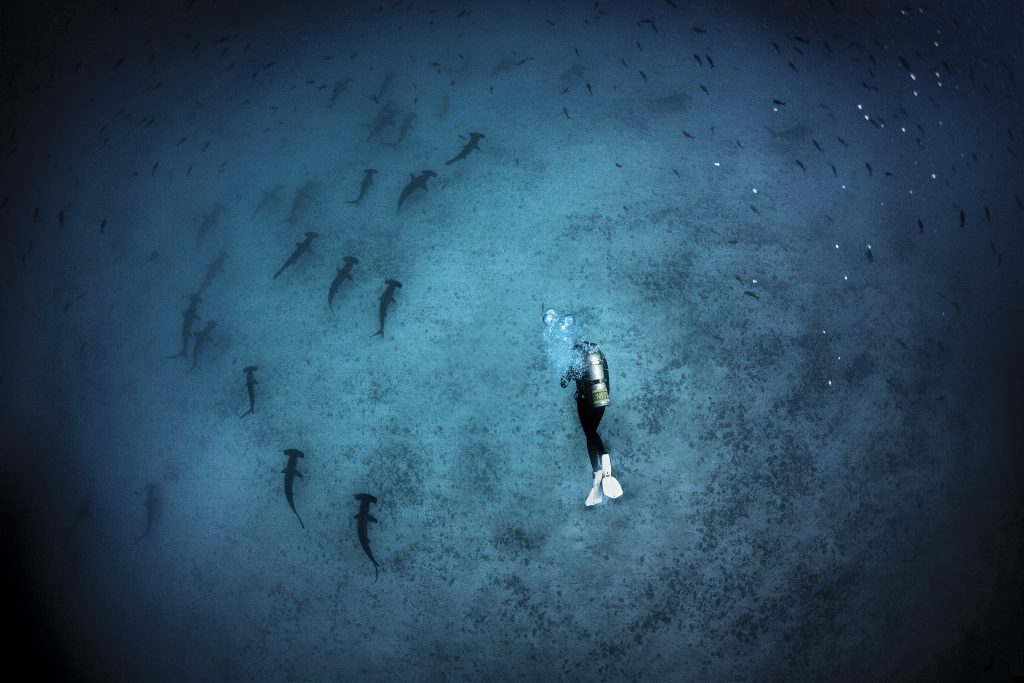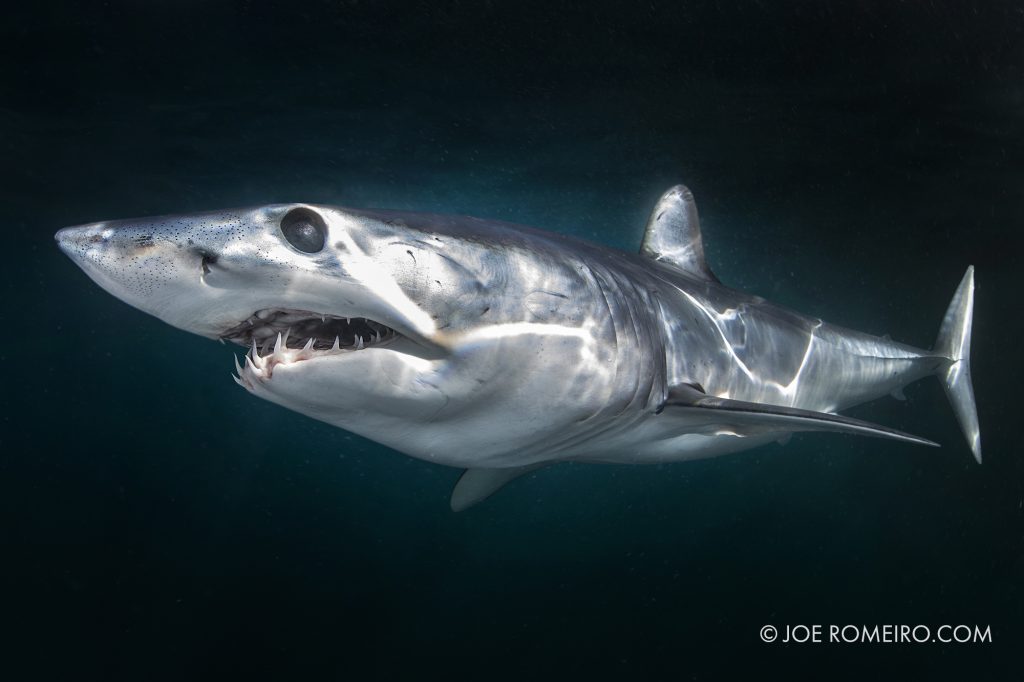Marine Life & Conservation Blogs
For PADI divers, every week is Shark Week!
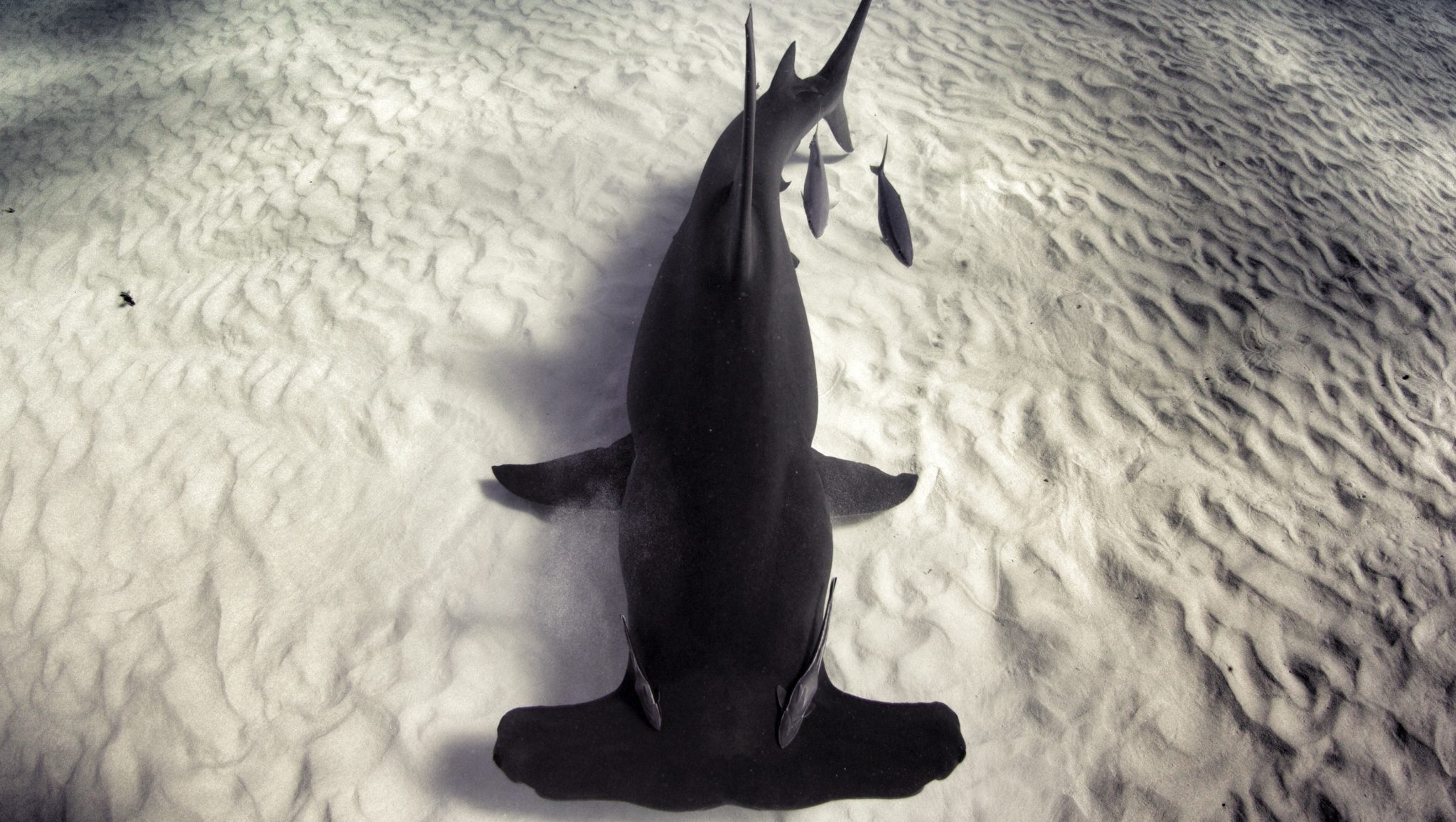
Some of our favorite places to have epic interactions with the stars of Shark Week – dive certification not always required!
We’ve been all around the world diving with sharks from the smallest shy shark to the giant whale shark. Here’s some of the best places in the world to swim, snorkel and dive with the iconic and most popular stars of Shark Week – including Whites, Bulls, Tigers, Great Hammerheads, and Mako Sharks – while shifting your perspective at the same time!
Great White Sharks – Guadalupe Island, Mexico
PADI Diving Certification required: None
Other Shark Species You’ll encounter: None (they don’t want to end up on the White Shark’s menu!)
Want to have the same experience people like PADI Diver Andy Casagrande film for Discovery’s Shark Week? Head to a remote archipelago off the coast of Baja.
Guadalupe Island is off the coast of Mexico and is absolutely epic for experiencing white sharks doing what they do best. This small volcanic island is located 150 miles off the west coast of Mexico and is home to approximately 170 great white sharks from July to November.
The water is crystal clear, topside conditions are usually great – and the action is incredible, and highly reliable. While we are dealing with wild animals that make their own itineraries, it isn’t unusual to see 20 – 30 different animals on a trip!
The island’s shores are havens for Guadalupe Fur Seals, Californian Sea Lions and Northern Elephant Seals. It also brings in incredible amounts of pelagic fish species like tuna. It’s a 24-hour diner filled with white sharks’ favorite food from late July through the end of each year.
Some of the biggest sharks in the world have been tagged in Guadalupe including “Deep Blue”. The action at the surface can be busy with the huge females hunting large elephant seals and from the in-water cages, it’s incredible to witness the social structures and the interaction between sharks.
Many operators serving Guadalupe Island offer the unique experience of liveaboard diving with great whites. While it may not be the easiest place to reach, thanks to the large population of migrating sharks and clarity of the water, this is a great choice for a great white shark encounter.
And you don’t need to be a certified diver! You’ll have surface supplied air and plenty of time in cages built for your – and the sharks’ safety.
Choose from 7 PADI Liveaboards in Guadalupe Island
Other White Shark Hotspots:
- Port Lincoln – Australia
- Gansbaii + False Bay, South Africa
- Farrallon Islands, California
- South Island, New Zealand
Tiger Sharks – “Tiger Beach”, Bahamas
PADI Diving Certification required: Open Water Diver or Freediver
Other Shark Species You’ll Encounter: lemon sharks, reef sharks, nurse sharks and the occasional great hammerhead
Named because of their unique stripes and impressive hunting style, tiger sharks can be found in tropical and sub-tropical regions around the globe. These beautiful marine animals can reach up to 5 meters/16 feet in length and can weigh up to 635 kg/1,400 lb.
Tiger sharks have gotten a bad reputation on Shark Week as being indiscriminate eaters (yes, it’s true a suit of armor and an unexploded grenade have been found in the stomachs of this species) – and dangerous sharks. However, swimming with one – whether snorkeling, freediving or diving is a life-changing experience. You’ll quickly realize that you are having an adventure of a lifetime as the fear melts away. And there is really no place on earth like this place off the coast of the Bahamas – that exists only below the surface.
About an hour by boat from the West End of Grand Bahama, Tiger Beach is famous and aptly named for its resident tiger sharks. Two to seventeen of these gorgeous animals reliably appear nearly every day of the year. Tiger Beach offers the chance to take part in some of the greatest shark diving in the world. You’ll get up-close encounters with not only tiger sharks but lemon sharks, the occasional hammerhead and plenty of whitetip reef sharks in the crystal-clear azure waters that only an aquarium can top in terms of visibility.
The best time to dive Tiger Beach is between October and January when the sharks use the area as a breeding ground. Shark Week has featured some of the residents being tagged or even giving birth – and hopefully you’ll even meet Emma, the world’s most famous Tiger Shark.
From Bimini or Grand Bahamas, you can head to the most spectacular tiger shark gatherings in the world by a day boat – or you can take a trip on a liveaboard departing from Southern Florida or the Bahamas. The easy surface conditions, 20-foot depth and gorgeous light make Tiger Beach accessible for freedivers and scuba divers alike.
View Dive Operators in the Bahamas
Other Tiger Shark Hotspots:
- Beqa Lagoon- Fiji
- Hawaii
- Aliwal Shoal – South Africa
- South Carolina – USA
Bull Sharks – Shark Reef, Fiji
PADI Diving Certification required: Advanced Open Water Diver
Other Shark Species You’ll Encounter: tiger sharks, gray reef sharks, nurse sharks, black tip reef sharks, silvertip sharks
Part of many different Shark Week episodes, bull sharks are well known sharks for many reasons – including a reputation for brutish behavior (which earns them their name) as well as the fact they are one of the most adaptable species of all sharks. They can survive in both salt and fresh water and can be found in most coastlines throughout the world. Although they’re portrayed as one of the more aggressive sharks on shark week, they are incredible creatures to see underwater and shouldn’t be missed. And there’s literally no better place to dive with bull sharks than Fiji – where you’ll find the biggest bull sharks in large numbers.
With the establishment of the Shark Reef Marine Reserve, Beqa Lagoon has become a premier shark diving area the world over. Bull sharks are the stars of the show here, but divers can encounter up to 7 other species as well. These include sickle lemons, gray reefs, nurse, blacktip reefs, whitetip reefs, silvertips and tiger sharks. With more than 20 dive sites in the lagoon, divers can fill a week or more with fantastic shark sightings. Although you will see sharks during any month of the year, July to September offer the best diving conditions in terms of visibility, water temperature and other large marine life.
As an added bonus, any diving done in the Shark Reef Marine Reserve finances shark research and compensates local fishermen for lost income due to the creation of no-take zones. It’s a win-win-win for sharks, divers and the local population!
A recent study in Fiji found that bull sharks form friendships with each other! Researchers studied data collected over 3,000 shark dives in Fiji’s Shark Reef Marine Reserve (SRMR), one of the world’s most sought-after diving destinations. SRMR is located in the Beqa Channel, off the southern coast of Viti Levu, and is a striking example of collaboration for conservation.
The shark is revered by local Fijians and legend has it that Dakuwaqa, the ancient shark god, provides protection for the people when at sea. So not only will you be exploring Fiji’s underwater world with your dive buddy, but you will likely encounter a pair of bull shark BFFs on your dive too!
View Dive Resorts in Beqa Lagoon
Other Bull Shark Hotspots:
- Bimini, Bahamas
- Playa del Carmem, Mexico
- West Palm Beach and Jupiter,Florida
- Protea Banks, South Africa
Great Hammerhead Sharks – Bimini, Bahamas
PADI Diving Certification required: Open Water Diver or Freediver
Other Shark Species You’ll Encounter: bull sharks, lemon sharks, reef sharks, nurse sharks and don’t forget the shark’s close cousin… the eagle ray
Bahamas makes it on our list twice thanks to the incredible conditions underwater (there’s actually a color named Bimini Blue), and the fact the Bahamas plays hosts to some of the most spectacular mega-fauna in the world – including the Great Hammerhead Shark.
There’s no mystery as to how the hammerhead shark got its name! That massive hammer – known as a cephalfoil – makes them one of the most distinctive animals on the planet. And that hammer isn’t just for show… It gives this shark superpowers which means the great hammerheads have seven finely attuned senses plus 360-degree vision (without turning their head!) to be able to avoid divers. Seeing a great hammerhead is rare as they tend to be quite skittish underwater, so finding a place you can reliably experience them is a rarity.
Every winter from December to March, great hammerhead Sharks gather around Bimini in large numbers. Naturally shy and reserved, these huge sharks with their odd faces become curious in this location, closely approaching divers. Shark diving is closely controlled due to the area’s marine park status. Although Bimini Island is a part of the Bahamas, it is located just 50 miles from Miami in the United States, making it possible to visit by boat in just three hours from the American city.
The waters of Bimini are warm, clear and typically protected. The shark dives occur in less than 20 feet of water allowing divers and freedivers to enjoy incredible encounters.
Plan a trip to Bimini to see the “hammers” and you’ll likely catch up with bull sharks, friendly dolphin pods, and graceful schools of eagle rays. You’ll feel like you stepped back in time to an island still not heavily commercially developed and traversed by golf carts. Bimini can be explored by divers and snorkelers alike – and is absolutely stunning above and below the surface. Head to nearby Honeymoon Beach to swim with the local group of rays as well – after all, rays are really just flat sharks!
Other Great Hammerhead Hotspots:
- Southern Florida, USA
- Rangiroa, French Polynesia
- Solomon Islands
Shortfin Mako Sharks – Rhode Island, USA
PADI Diving Certification required: None
Other Shark Species You’ll Encounter: blue sharks
Mako sharks get nearly as much airtime on Shark Week as white sharks, thanks to their incredible biology, although the fact they are in the same shark family as whites (mackerel) probably doesn’t hurt!
Shortfin mako sharks are sometimes described as miniature great whites on amphetamines. These toothy sharks look like a shrunken-down version of the ocean’s top predators, but they act totally differently. While great white sharks slice slow, graceful circles around a diver, watching with an inquisitive eye, makos are twitchy sharks, hopped up on adrenaline, that speed past you.
Thought to be the fastest sharks in the ocean, makos have an estimated top speed burst of about 45 mph. They can achieve these speeds thanks, in part, to their ability to thermoregulate – meaning they can warm their body temperatures. Incredible acrobats, like great whites, makos are known to jump out of the water, sometimes up to 20 feet in the air, using their perfectly shaped fins as wings and rudders.
Equally impressive, they have the largest brain to body mass of any study shark as well. So they have it all – beauty, brains and braun.
Makos are pelagic sharks that live throughout the world’s oceans, but there are only a handful of places where you can have reliable encounters with these incredible creatures. Our favorite, most reliable place? Rhode Island. Plus, you don’t even have to be a diver!
Most people don’t think of Rhode Island as a shark-diving hot spot, but during the summer months, when the Gulf Stream moves close to shore, this stretch of New England coastline becomes a haven for makos and other sharks, as game fish move closer to shore. You can even join PADI divers, PADI AWARE supporters and Shark Week celebrities Joe and Lauren Romiero as they film and study the local mako population on their dive charter.
Even if you miss the stars, the equally charismatic blue sharks steal the show.
Other Mako Hotspots:
- Baja Sur, Mexico
- Cape Point, South Africa
- San Diego, California
- Azores
Header Image Credit: Andy Casagrande @ABC4EXPLORE
Blogs
Saba’s Plan for a Coral Comeback

Saba has an exciting new initiative to restore its coral reefs. This new project, running from 2024 to 2026, will focus on reviving key species in the island’s underwater ecosystems. With a collaborative team from the Saba Conservation Foundation (SCF) and Van Hall Larenstein (VHL) University of Applied Sciences, the project aims to restore both corals as well as sea urchins.
This initiative is centered around coral restoration, specifically reviving two essential coral species—staghorn coral (Acropora cervicornis) and elkhorn coral (Acropora palmata). By mapping parent colonies and using a technique known as coral gardening, SCF will create and maintain coral nurseries. These corals will eventually be outplanted at key reef sites around Saba to not only expand the number of coral colonies, but also provide essential fish habitat. The project focusses on installing coral nurseries, training staff with the newest techniques and starting with the restoration of key reef sites.

Reef Cleaners to the Rescue
It’s not just corals getting a makeover—this project also shines a spotlight on the essential role of grazers, particularly sea urchins. VHL is leading the charge on cultivating and restocking two key sea urchin species, West Indian sea egg (Tripneustes) and long-spined sea urchin (Diadema), known for their ability to keep algae in check. By removing algae, which are important competitors of corals, they help the coral to thrive. By restoring these “reef cleaners,” Saba’s project will give corals the breathing room they need to grow, setting the stage for a healthier, more balanced marine ecosystem.
From Tiny Urchins to Big Goals
The project will be funded as part of the Dutch Government’s Nature and Environment Policy Plan (NEPP) 2020-2030 for the Caribbean Netherlands, a comprehensive initiative aimed at conserving and restoring the unique natural environments of the Dutch Caribbean islands, including Saba, St. Eustatius, and Bonaire. This project is aiming for big milestones: build and maintaining coral nurseries, the expansion of urchin cultivation facilities, and the creation of a dedicated research center. By 2026, the project hopes to ramp up coral and grazer restoration, with the ultimate goal of extending these efforts across the Dutch Caribbean. By linking local initiatives to broader regional goals, Saba’s restoration project promises to leave a lasting impact on both the environment and the community.
Find out more about the DCNA at dcnanature.org.
Blogs
Reef-World marks two decades of marine conservation: strengthening impact amid coral reef threats

Empowering ocean stakeholders to tackle future challenges and ensure the survival of coral reefs and humanity
2024 marks the 20th Anniversary of The Reef-World Foundation’s tireless efforts for global coral reef conservation. The UK charity is the international coordinator of the UN Environment Programme’s Green Fins initiative, known as the leading voice in sustainable marine tourism. Today, Reef-World released its 2023-2024 Impact Report outlining a year of substantive growth and impact in its marine conservation programmes.

Impact Report Highlights:
- Impressive improvements in environmental behaviours to protect coral reefs by the marine tourism industry as the global participation of Green Fins increases.
- Continued capacity building for government and NGO staff to effectively manage marine tourism activities in Asia, Caribbean and Red Sea regions.
- For the first time in Green Fins’ 20-year history, tourism operators have achieved ‘Best Environmental Performer’ status by demonstrating the lowest possible environmental impact in their environmental assessments. In 2024, three dive operators achieved this challenging milestone.
- Significant increases in global participation of Reef-World’s innovative digital conservation tools.
- 138 Green Fins dive operator members achieved the strict threshold for PADI Eco Center recognition.
- Developed four new educational materials and translated two into 16 languages to support the marine tourism industry in achieving sustainability targets.
- Establishing a new Reef-World Development strategy and recruiting new roles – Development and Programmes Managers.
- Reef-World’s board welcomes new Chair and Trustees strengthening organisational leadership.

Reef-World started as a one-person mission to inspire and empower communities to act in conserving and sustainably developing coral reefs and related ecosystems. Today, the team of 12 continues to meet this mission by inspiring and empowering the global marine tourism community to be exemplary sustainability leaders by using the Green Fins guidelines and tools to simultaneously use and protect the world’s precious reefs.
In April 2024, the fourth global coral reef bleaching event was confirmed. Reef-World’s work has never been more urgent as the marine environment, and the benefits they provide humanity, continue to be eroded by global threats. The reduction of local threats, like those from the marine tourism industry, is an essential step to ensuring a future where coral reefs survive and continue to support the millions of people who depend on their ecosystem benefits. Reef-World’s work buys time for coral reefs and related ecosystems to be resilient to the impacts of global threats.
“Right now our corals are facing the greatest fight of their existence as the terrifying predictions of the steps towards their complete extinction are starting to come true. But all is not lost, reefs are resilient and they have existed on this planet for millions of years. We must take action now, to buy time for reefs by reducing threats facing them and allowing them to react and adjust to the changing environment they need to survive in.” – Chloe Harvey, Executive Director
Looking Forwards:
Like coral reefs, the Reef-World team needs to be resilient in the face of the complex challenges of the conservation sector. Reef-World has invested significantly in developing a Culture of Care to ensure the well-being of its team on a daily basis, continuing to be an exemplary employer to enable its team to best achieve the mission for coral reef conservation.
With the foundations of a Culture of Care and organisational development laid, Reef-World is emerging from the end of a natural organisation life cycle, that brings the challenges of growth and scale, stronger than ever. With a new strategy in place to generate much needed resources, Reef-World is excited for the opportunities to leap forward, continue to scale our impact and lean into new innovations and untapped opportunities for marine conservation.
We continually strive to become a forward-thinking organisation that delivers on our goals and commitments to our stakeholders with fresh approaches and not being afraid of steering away from a “normal approach.” This approach is not only applied to our programmes of work but also internally and carries over to our Culture of Care for our team.” — JJ Harvey, Operations Director

The Reef-World Foundation is immensely grateful for the continued support of its grant funders: UN Environment Programme, IUCN’s Blue Natural Capital Financing Facility, Adventure Travel Conservation Fund, PADI Aware Foundation, and World Nomads Footprints Program.
Reef-World would also like to express its gratitude to international partners whose vital support has resulted in significant tangible benefits for our work and mission: PADI; Professional SCUBA Schools International (PSS); Explorer Ventures; 1% for the Planet; ZuBlu; Snorkel Venture, GSTC; Dive O’Clock; Seven Dragons; DiveAssure and Eco Beach, without whom these achievements would not be possible.
The full 2023–2024 Annual Impact Report is available on Reef-World’s website.
-

 News2 months ago
News2 months agoIconic SS United States to become the World’s Largest Artificial Reef
-

 News3 months ago
News3 months agoBook Review – 52 Assignments: Underwater Photography
-

 Gear News3 months ago
Gear News3 months agoDYNAMICNORD – New German diving brand enters the British market
-

 News3 months ago
News3 months agoExploring Cenote El Pit: A Diver’s Dream
-

 Gear News3 months ago
Gear News3 months agoTry BARE drysuits (and maybe even win one!) this Friday with Sea & Sea at North West Dive Fest
-

 Marine Life & Conservation3 months ago
Marine Life & Conservation3 months agoBook Review: Coral Triangle Cameos
-

 Blogs2 months ago
Blogs2 months agoDive the Egyptian Red Sea this Autumn with Regaldive
-

 News3 months ago
News3 months ago2024 Ocean Art Underwater Photo Competition Announced


